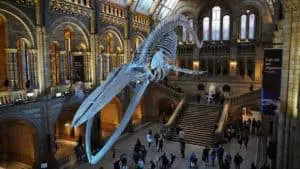Eostre: The Germanic Goddess of Dawn and Spring Equinox Celebrations

Updated On: April 17, 2024 by Raghda Elsabbagh
Ever found yourself pondering whether there’s more to the name ‘Easter’ than meets the eye? This intrigue led us down an intriguing rabbit hole, where we unearthed tales of an ancient Germanic goddess named Eostre, the goddess of dawn and the spring equinox celebrations.
But before we dive too deep, let’s set the stage. Imagine yourself standing at the cusp of spring, feeling the warmth of the sun on your face as winter’s chill finally begins to loosen its grip. This moment marks the arrival of the spring equinox, a time when day and night stand in perfect balance, heralding the promise of renewal and rebirth.
In this piece, we’ll explore fascinating insights about Eostre and her ties to dawn and spring equinox celebrations and how these have evolved in modern times. So, grab a cup of tea, cosy up, and prepare yourself for a captivating tale of the Germanic goddess Eostre!
Table of Contents
Who is Eostre?
Eostre is a Germanic goddess associated with the dawn and spring equinox celebrations. Sometimes, people also call her other names, such as Ostara or Eastre.
Eostre in Germanic Mythology
Alright, let’s dive into the fascinating realm of Germanic mythology and uncover the mysteries surrounding Eostre!
Origins and Etymology of the Name “Eostre”
First off, let’s talk about her name. Eostre, doesn’t it have a certain lyrical quality to it? Well, that’s because it’s derived from the Old English word “Ēastre,” which itself traces back to the Proto-Germanic goddess of the dawn. Yep, you heard that right — Eostre is literally the embodiment of the dawn, bringing light and hope to the world after the darkness of night.
We have a common word today that sounds like her name, too! Can you guess it? Yes, it’s Easter! The spring holiday got its name from this ancient goddess.
Description by Bede
Bede, an Anglo-Saxon scholar, described Eostre as a goddess associated with dawn and the spring equinox. In his writings, he mentioned that April was named after her in ancient Germanic tradition.
According to Bede, Eostre’s festival was celebrated during this time as a way of welcoming the arrival of spring and new beginnings. He also noted that she represented fertility and rebirth, symbolising the awakening of nature after winter.
These descriptions by Bede give us valuable insights into how the goddess was perceived in Germanic mythology and help us understand her significance in ancient traditions celebrating the changing seasons.
Theories and Interpretations (Jacob Grimm)
Jacob Grimm, a German folklorist and linguist, provided some theories and interpretations about the goddess. He believed that she was an ancient Germanic deity associated with fertility and the dawn.
According to Grimm, Eostre’s name is connected to the Old High German word “ostar,” which means “to shine.” This suggests her association with light and the rising sun. Additionally, Grimm speculated that Eostre might have been worshipped during springtime to honour the rebirth of nature after winter. These theories give us insight into how the goddess was perceived in ancient Germanic mythology and how she continues to be celebrated today as a symbol of renewal and new beginnings in modern paganism.
Depictions and Characteristics of Eostre in Germanic Folklore

When it comes to the goddess’s depictions and characteristics, picture her as a radiant goddess adorned with garlands of flowers, her golden hair glowing like the first rays of sunlight at dawn. She’s often depicted surrounded by symbols of fertility and growth, embodying the spirit of spring in all its lush abundance.
Comparison With Other Spring Goddesses in Different Mythologies
But here’s where it gets really interesting — Eostre isn’t just a lone ranger in the world of spring goddesses. Oh no, she’s part of a whole pantheon of deities from different cultures who share similar roles. Take, for example, the Greek goddess Persephone or the Roman goddess Flora — both of whom are associated with spring, fertility, and the cycle of life and death. It’s like they’re all part of one big cosmic sisterhood, each bringing their own unique flavour to the season of renewal.
Want to keep exploring? Let’s discover even more about this goddess of dawn and spring equinox celebrations.
The Spring Equinox Celebration
Now, step into the shoes of your ancestors thousands of years ago, when the spring equinox celebration wasn’t just a date on the calendar. This was a time when the world was waking up from its winter slumber, and people were eager to welcome the return of warmth, light, and life.

Historical Background of the Spring Equinox Celebration in Germanic Cultures
In Germanic cultures, the spring equinox marked the official end of winter and the beginning of the growing season. It was a time of great anticipation and joy, as communities came together to celebrate nature’s renewal and the promise of abundance to come.
But what did these celebrations look like, you ask? Well, they were nothing short of spectacular! The spring equinox was a time for merrymaking and revelry, from bonfires and feasting to dances and rituals. And at the centre of it all was none other than our girl, the goddess of dawn and spring.
Rituals and Traditions Associated with Eostre and the Spring Equinox
Rituals and traditions associated with Eostre and the spring equinox varied from region to region, but they often involved offerings of food, flowers, and other gifts to honour the goddess and ensure her blessings for the coming year. People would also decorate their homes and villages with symbols of fertility, such as eggs and flowers, as a way of invoking Eostre’s power to bring new life to the land.
Cultural Significance of the Spring Equinox Celebration in Germanic Societies
But beyond the festivities, the spring equinox celebration held deep cultural significance for Germanic societies. It was a time to reconnect with the natural world and to acknowledge the cycles of birth, growth, and death that governed all life. It was a reminder that no matter how harsh the winter or how dark the night, spring would always come again, bringing with it the promise of hope and renewal.
Eostre in Modern Culture
Let’s fast-forward a bit and examine how our girl Eostre is coping in the modern world—but let us tell you, she’s still as radiant as ever!
Influence of Eostre on Modern-day Celebrations of Easter
First up, let’s talk about the influence of Eostre on one of the biggest celebrations of the year: Easter. Yep, you heard us right — that Easter bunny hopping around with all those colourful eggs? Well, it turns out they’ve got a lot to do with the goddess. In fact, the word “Easter” is derived from her name. The goddess represents renewal and rebirth, which aligns with the themes of Easter. Just as Eostre brings about the renewal of life in spring, Easter celebrates new beginnings.
When Christianity spread throughout Europe, it absorbed many of the traditions and symbols associated with Eostre and the spring equinox celebration. So, that’s why we have things like Easter eggs, which symbolise new life and fertility, and the Easter bunny, which’s kind of like Eostre’s fluffy little mascot, symbolising fertility and rebirth. It’s like a big ol’ mash-up of ancient pagan customs and Christian beliefs all rolled into one.
Association with Hares
Eostre is often associated with hares, which are seen as a symbol of fertility and rebirth. In ancient Germanic folklore, hares were believed to be magical creatures that brought new life to the land during springtime. This connection between the goddess and hares has carried over into modern traditions, such as the Easter Bunny. The tradition of decorating eggs for Easter also stems from this association, as eggs represent new life and renewal.
Adaptations and Reinterpretations of Eostre in Contemporary Art, Literature, and Popular Culture
But Eostre’s influence doesn’t stop there — oh no, she’s been popping up all over the place in contemporary art, literature, and popular culture. From fantasy novels to Hollywood movies, the goddess’s timeless story of renewal and rebirth continues to captivate audiences around the world. And let’s not forget about all those artworks inspired by her — we’re talking paintings, sculptures, even tattoos.
Continuation of Spring Equinox Traditions in Modern Germanic Communities and Paganism

Even in modern Germanic communities, the traditions of the spring equinox are still going strong. Sure, they might look a little different than they did thousands of years ago, but the spirit of celebration and reverence for nature remains the same. In neopagan traditions, Eostre is often associated with the goddess Ostara, who represents new beginnings and growth. Various rituals and festivities are held to mark this time of year.
Whether it’s gathering around a bonfire, planting seeds in the earth, participating in outdoor ceremonies to welcome the arrival of spring, or simply taking a moment to appreciate the beauty of the world around us, the legacy of the goddess of dawn lives on in the hearts and minds of those who still honour her ancient rituals.
Eostre is a goddess in Germanic mythology who is associated with the dawn and spring equinox celebrations. She symbolises fertility, renewal, and the changing of seasons. Her name has even been connected to the holiday of Easter that we celebrate today. This goddess’s story shows us the importance of honouring nature’s cycles and appreciating the beauty and rebirth that come with each new spring.
FAQs
1. Who is Eostre in Norse mythology?
Eostre is a goddess of dawn and spring in Anglo-Saxon or Germanic tradition, often linked with light and fertility.
2. What does Eostre symbolise?
As a light deity and fertility goddess, Eostre symbolises the coming of new life and warmth after winter’s end.
3. Is there a celebration for Goddess Eostre?
Yes, many people honour Eostre during the Spring Equinox as part of pagan holidays in the German tradition.
4. Why do we connect the name “Easter” to this mythical figure?
In some beliefs, the word “Easter” came from “Eostre”, showing her influence on modern culture even today.






